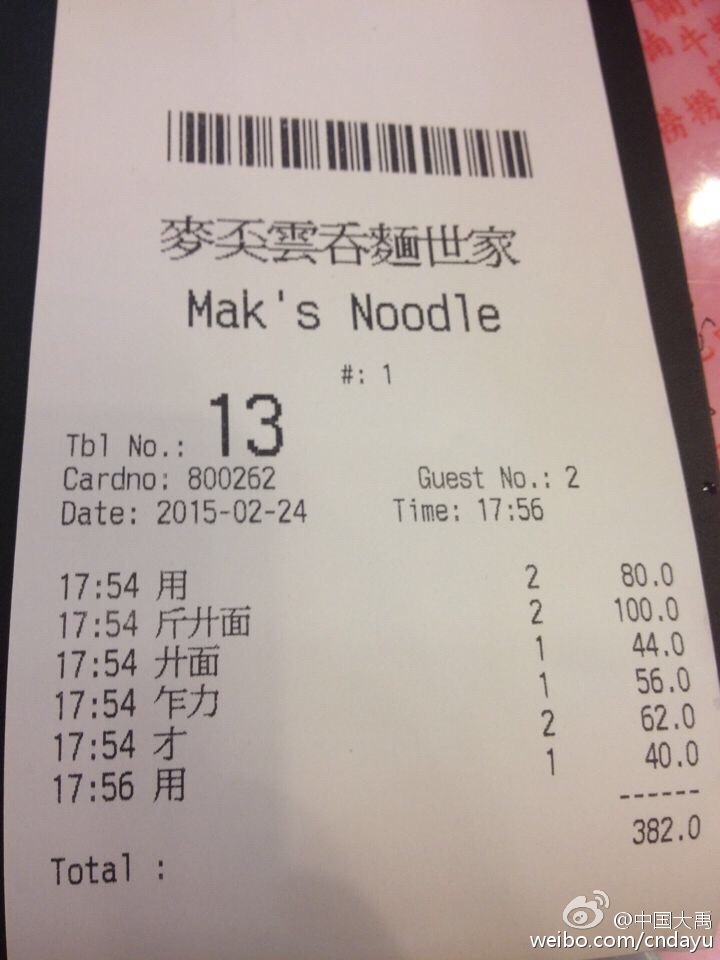Hong Kong-specific characters and shorthand
« previous post | next post »
Joel Martinsen found this photograph on the microblog of Wáng Dàyǔ 王大禹:
It's an itemized receipt for a meal at a traditional Cantonese restaurant in Central Hong Kong. In Cantonese, the heading reads:
Mak6 An1 wan4tan1 min6 sai3gaa1
Simplified characters: 麦奀云吞面世家
The MSM pronunciation would be: Mài Ēn yúntūn miàn shìjiā
English: Mak Ngan's Family Style Wonton Noodles
Mak6 麥 is the surname of the owner, and ngan1 / an1 奀 is the nickname of the founder of the Hong Kong Mak family wonton noodle establishment. 奀 is a compound graph, composed of the characters for "not" (bat1 不) and "big" (daai6 大), hence "skinny; puny; small (quantity); meager (salary)". Mak Ngan had this curious name because, as a child, he was extremely skinny. His real name is Mak King-hung 麥鏡鴻.
Wonton is known to practically everybody who reads Language Log, and we've had a few posts about it:
- "Wanton soup " (1/5/15)
- "Wantan soup for überman hubby " (3/15/14)
In this context, sai3gaa1 世家 refers to a family with a hereditary skill, in this case the cooking ability that has passed from generation to generation.
Enough on the heading.
I will not systematically translate all of the ordered items, but will focus on one special usage that is obvious and nearly universal among waiters and waitresses, namely, the shorthand form coi4 才 for coi3 菜 ("vegetable; dish").
As for the short forms for the other items, those who are interested in pursuing them can find information here and here.
Wang Dayu's microblog referred to above offers explanations of several of the other items, e.g., jung6 用 (lit., "use; employ; apply; operate"), which apparently stand for an order of wonton noodles.
Perhaps Calvin or someone else who has worked in a Cantonese restaurant might be inclined to explain one or more of the remaining items.
[Thanks to Bob Bauer, Fangyi Cheng, Rebecca Fu, Linda Greene, and Diane Moderski]

Matt said,
March 17, 2015 @ 7:55 pm
It's interesting that 才 is also used as a replacement character in Japanese, but with a completely different target. Specifically, 歳 as in "years old" — the standard curriculum doesn't teach that one until middle school, so 才 is a useful placeholder (and actually 歳 is such a hassle to write that many people keep using 才 well into adulthood, some not even realizing/remembering that 歳 is the "correct" character for that purpose).
I wonder if anyone has looked at this phenomenon from a cross-cultural perspective — which replacement usages spread across the whole hanzisphere, and how (including within China itself), which (if any) traveled back from Korea/Vietnam/Japan to China, etc. I know that the general phenomenon of Chinese character writing styles (including simplifications) has been looked at this way, but I don't recall seeing anything that dealt with replacements in particular.
Abraham Chan said,
March 18, 2015 @ 1:54 am
用:雲吞麪
斤廾面:牛筋牛腩麪
廾面:牛腩麪
乍力:炸醬撈麪
才:油菜
Calvin said,
March 18, 2015 @ 1:55 am
Translation of the menu items…
用: 雲吞麵. Wonton with noodles. It is normally written as 蓉, but pronounced as jung2. Best reference I could find: http://weishenmea.com/wei-shen-me-839973.html
斤廾面: (牛)筋(牛)腩麵. Beef sinew and brisket with noodles. 斤 is homophone and 面 is the simplified form. The character 腩 is substituted by 廾, which is the radical of the homophone 藍.
廾面: (牛)腩麵. Beef brisket with noodles.
乍力: ?? I have not idea. My best guess is 炸醬麵 (http://en.wikipedia.org/wiki/Zhajiangmian) since 乍 is a homophone of 炸 and 力 resembles the top-right component of 醬.
才: (油)菜 Poached vegetables (usually 芥蘭: http://en.wikipedia.org/wiki/Kai-lan).
Abraham Chan said,
March 18, 2015 @ 12:52 pm
I thought the character 力 stands for 撈.